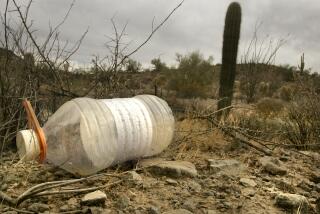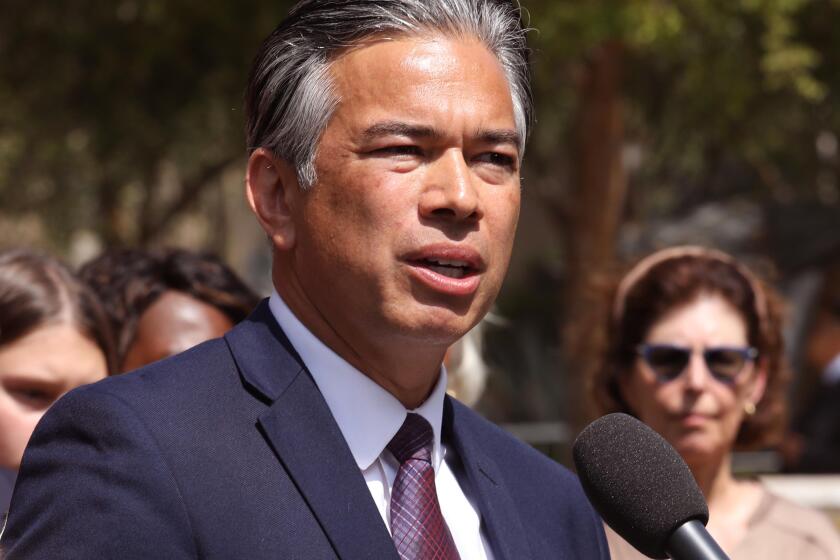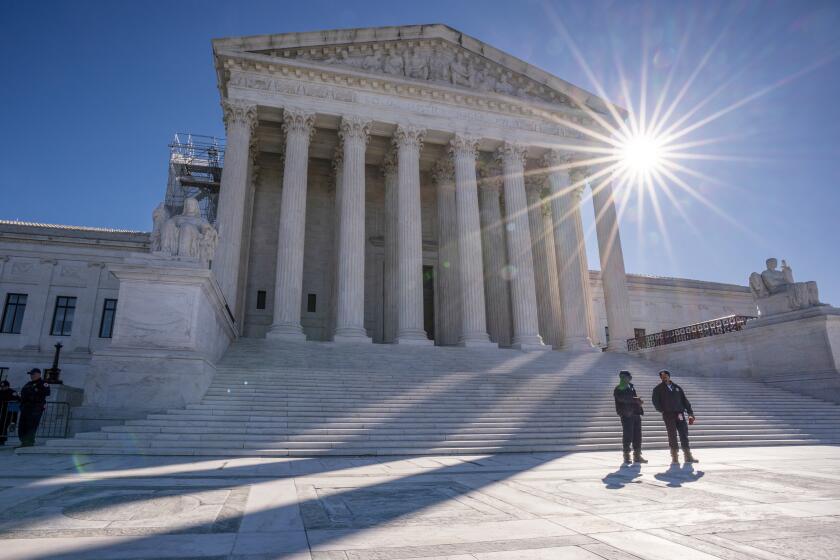Kurds Cling Precariously to Life in Turkish Mountains
- Share via
ISIKVEREN, Turkey — There are two hairpin turns on the road to Nightmare. A plodding yellow road grader works the curves, but it is no match for the mud that wells from the earth even on a cloudless day.
Huge traffic jams build in frustration below. Above, there is horror. Trucks wait. People die waiting for them.
Thus has spring come this year to the lovely mountains of southeastern Turkey and to a 7,000-foot-high pasture so remote that a few weeks ago it barely had a name.
Now it is Nightmare, a place Dante might have known.
It is a place where industrious 6-year-olds in long skirts, mothers’ helpers, scrounge for water in puddles, and their older brothers wrestle for scraps of food. It is a place where cries ignite the cold mountain night, and there are impromptu funeral processions all day.
It is the place where tens of thousands of hapless Iraqis languish in unspeakable misery after making the mistake of rebelling against Saddam Hussein.
They are not alone. Their kin are strewn across a broad, gray swath of mountainside along the 209-mile Turkish-Iraqi border, 400,000 souls in a dozen concentrations. Everyone has seen the television pictures by now, but the pictures can’t convey the reality, the sights and the smells.
Few things are clear after a visit, but one of them is that many more people will die before Nightmare is no longer part of the landscape. Another is that some of those who are saved will be spared because Americans saved them.
Ibrahim Jalal came to this place running scared. A middle-aged, mustachioed clerk in a school in the northern Iraqi city of Zakhu, he walked across the mountains with his wife and seven children to save their lives.
Like Jalal, most of the refugees are Kurds, a Muslim, non-Arab people who dream of an independent Kurdistan and who were systematically repressed by Hussein. They revolted when the Persian Gulf War ended, and for a heady two weeks, Kurdish insurgents controlled northern Iraq.
Then the Iraqi army came with a savagery that is Hussein’s trademark when confronted with dissent. The army killed the rebels and butchered their civilian supporters. To escape the onslaught, whole cities emptied as April dawned. The nearly half a million refugees crouched on Turkish mountains, and another million like them in Iran, are survivors. For how long?
“This is not a human place. We are like animals here,” said Rakeb Mahmoud, a 25-year-old refugee.
Saving the refugees has become the goal of an unprecedented humanitarian effort by the U.S. armed forces amid a general recognition that no combination of international or private agencies has resources enough for the enormous task. The Americans are massing a giant fleet of helicopters to battle the mountains.
For the land-bound who would try to move supplies up to the refugees, though, the surest escape from the snarl at the mountains’ base is to hitch a ride on a tractor. Farm tractors around Isikveren are not plowing this spring. They are towing water tanks, an agonizing one at a time, to the refugees who quickly drink them dry.
It takes a jolting hour along a narrow and frightening dirt track to reach the upland meadow that, not long ago, was stunted with scrub oak and the prospect of good grass as winter eased. The grass is mud now, and the oaks are almost all gone, hacked to pieces for firewood.
There is an administrative base camp of sorts at a clearing where, a few weeks ago, Turkish conscripts stopped the refugee advance down the mountain toward the Turkish border. Turkey has reluctantly agreed to accept about 40,000 refugees, but no more. The United States says it will settle the rest, beginning in about two weeks, in camps it intends to build in northern Iraq. And there is now what may develop into a rival plan set up by Iraq and the United Nations, to help those same refugees.
The tractor towing a yellow tank of about 250 gallons of water doesn’t stop at the base camp. It labors up an even narrower track, ever higher, that offers new horror with each turn. Lean-tos, nylon shelters and recently arrived tanks are scattered haphazardly in all directions, almost to the snow line.
Refugees attack the water tank as the tractor edges higher, running behind it with basins, tins and plastic bottles. Others jump aboard for the ride. The water guard atop the tank halfheartedly shoos them off. Turkish soldiers at checkpoints every few hundred yards do a better job.
The soldiers are there to see to it that the refugees do not flee the areas where chance has scattered them. Lower down is dirtier, but it is also less cold.
When the tractor finally stops, it is rushed by hundreds of refugees who push and shove and finally, under prodding of Turkish soldiers, form a line to empty the tank from half a dozen faucets at its tail. Another fact of refugee life in the Turkish mountains this spring is that the strongest and the most agile get the most supplies.
The United States learned that axiom when it began airdropping supplies to the camp: survival of the fittest. The lesson now comes home again in the mobs that rush every newly arriving American supply helicopter.
“Food is not a problem. We have rice, pasta, bread, everything,” said Youssef Mohammed Ali, who fled Iraq with three strapping sons.
“We have had one piece of bread in two days,” said Nidal Ahmed, who is seven months’ pregnant and came with her husband and three children, all under 6. All three youngsters have diarrhea. So do 90% of the other children at the camp, say American medics here.
At first, the nights were very cold, and the cold killed. Except for the blankets that they brought with them, refugees like the family of school clerk Jalal had no protection. They scrambled for water, food and firewood by day, huddled together by night, and waited for help.
It was slow in coming. And too late for Jalal’s 3-year-old daughter. She died last week.
Salaam Hassan was luckier. He snagged an airdropped piece of nylon sheeting early on, and now, after 15 days on the mountain, has a real tent, courtesy of the Spanish Red Cross, to house his extended family of 15.
“It was five days after I got the tent before Turkish soldiers let me put it up,” the 30-year-old Hassan said.
Shelter is a lessening crisis now, and so is food, as American helicopters arrive with half-ton loads with the regularity of buses, and trucks that brave the mountain track depart with refugee families for the lone Turkish-run refugee camp.
It is unpleasant to report and worse to see, but one of the ways of judging conditions in the camp--the worst of them all because it is overcrowded, far from a road and disorganized--is to study the ground. There is no sanitation whatsoever for what are variously estimated at between 65,000 and 100,000 people.
Five different encampments are reached via the carved mountain track. The people in them come from 13 different clans, according to Chief Warrant Officer Tracy-Paul Warrington of Simi Valley, Calif., a member of the small American military team here helping to supply and organize the refugees.
In four of the encampments, there is already order, Warrington said, because most of the people in them respond to their clan leaders. The military camp is chaotic and so far uncontrollable, he said, because most of its refugees are from the cities and far from their clan roots. There are doctors, teachers, judges, Muslim imams and rich merchants here, he said, but no fabric of leadership.
Even if the Americans are as quick as they promise in building the camps in Iraq--and international relief specialists are skeptical--it will be weeks before Nightmare is gone.
For many, that may be too late. Water is critically scarce, and the threat of epidemic is extraordinarily high as the weather warms, according to physicians at a stopgap and overwhelmed clinic run by a Paris-based relief group called Physicians Without Frontiers.
“People cannot stay here much longer. If the sanitation conditions are not better and it gets hotter, anything can happen,” said Dr. Bert Myman, a Dutch volunteer with the French group. “And if we get measles, God help the children.”
The young Americans who arrived in the camp this week have clearly made a difference. But there is a long way to go--perhaps too long.
“Today I saw the first fly. We tried to dig a ditch for a latrine but abandoned it when they started washing their pots and pans there,” said Special Forces Sgt. Kevin Barnes, who helped in the overnight construction of the landing zone here.
The Americans sleep in tents on a flat space they bulldozed from the mountainside. A few yards away is the cemetery: On average there are 22 new stone-covered burial mounds each day--16 children, four men and two women; average age of the adults is 35. That toll is for one-fifth of the camp. The other four areas have their own new instant cemeteries.
At the cemetery here, a small knot of Kurds gather in the shank of a crystal afternoon. They talk of their flight, their plight and what they hope will be their eventual return to their homes.
And they talk of their friend and relative Ibrahim Jalal, who fled his school post only to quickly lose one of his children to the mountain. And then, in mourning, to fall sick himself. A good man, they said, a loving father.
All there was to see of Ibrahim Jalal was his last pair of black socks. They poked out from under a blanket as relatives hacked one more new grave from the stubborn mountain mud. Jalal’s nightmare was over.
Free-lance journalist Hugh Pope contributed to this story.
More to Read
Sign up for Essential California
The most important California stories and recommendations in your inbox every morning.
You may occasionally receive promotional content from the Los Angeles Times.










